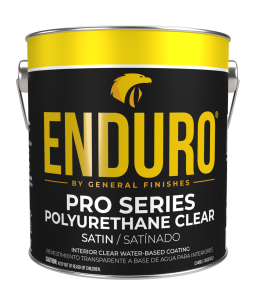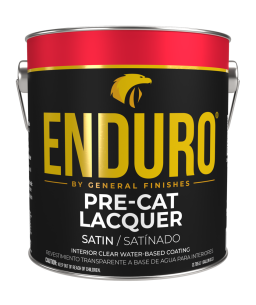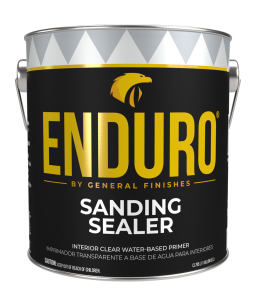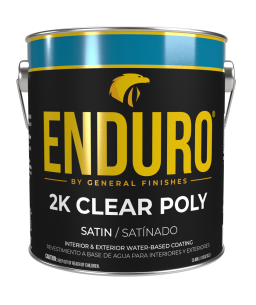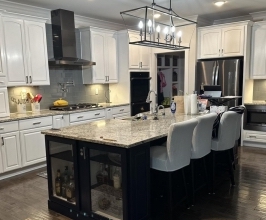We recommend using Colourfal Zero VOC colorants. Other colorant systems should be zero VOC, incorporated at the point of use, and tested thoroughly for performance before application. General Finishes will not be liable for in-can stability when other colorants are used.
Instructions
Step 2: Preparation
All wood projects require preparation sanding. If you skip this critical step, your finish may fail.
Raw Wood
See our video: How To Prep Sand New Wood
- Sand with 120-grit sandpaper, followed by 150 or 220-grit.
- Remove dust.
Sealed Surface
See our video: How to Prepare Existing Finishes
- Scuff clean with a non-woven abrasive pad & 50:50 mix of denatured alcohol & water.
- Dry 1-2 hours.
- Sand lightly with 220-320-grit sanding sponge.
- Remove dust.
Step 2: Priming
CAUTION: Do NOT use Enduro 2K Clear or any clear topcoat over white paint, as it may cause yellowing.
2K WHITE POLY PRIMING RECOMMENDATIONS:
INTERIOR RAW WOOD: 2K White Poly is designed to adhere to raw wood. Can be used without a sealer.
SEALED SURFACE: When applying 2K White Poly over an existing sealed surface, ALWAYS PRIME with Enduro White Undercoat for interior/exterior use or GF Stain Blocker for interior projects where tannin bleed-through is a concern.
2K CLEAR POLY PRIMING RECOMMENDATIONS:
INTERIOR RAW WOOD & STAINED SURFACES: 2K Clear Poly is designed to adhere to raw wood and newly stained wood. Can be used without a sealer. Use 1-2 coats of Enduro Sanding Sealer for an improved build. 3-4 total coats are recommended.
SEALED SURFACE: If tinted and applying over an existing sealed surface, ALWAYS PRIME with Enduro White Undercoat or Enduro Deep Base Primer for interior/exterior use or Enduro Stain Blocker for interior projects.
Disclaimer
Although Stain Blocker is engineered to prevent the most persistent bleed-through when 2 coats are applied, General Finishes cannot guarantee the prevention of bleed-through or yellowing on every project. Unknown factors and assiduous bleed-through can impact results. Stain Blocker is the most robust option and has performed extremely well in our tests.
Step 3: How to Apply Enduro Pro Series White Polyurethane
CAUTION: Do NOT use topcoat over Enduro Pro Series White Polyurethane or any other white or light paints such as GF Milk Paint, or Enduro White Poly as it may cause yellowing. Any clear coat can become reactive over wood substrates or existing finishes, causing tannin or dye bleed-though regardless of priming. All of GF's white paints are self-sealing and do NOT require a topcoat.
Join the Enduro Wood Coating Pros Facebook Group at for customer support and learning opportunities specifically for General Finishes Pro line of Enduro products. This group is a great resource for guidance regarding choosing the right product, mastering finishing techniques, troubleshooting, or sharing your finished projects with other pros.
Download 2024 Professional Water-Based Product Catalog here.
General Finishes Enduro Pro Series Topcoat Application Steps
- Settling is natural. Stir thoroughly to reincorporate solids that have settled to the bottom of the can before and throughout the application process. Do not shake.
- Test for adhesion when applying over an existing finish.
- Thin as desired with distilled water; start with 5%, adding up to 10% by volume.
- Increase open time, if needed, with 10-15% General Finishes Extender if allowed by local regulations. GF Extender will improve flow and leveling and increase open time, which is helpful in dry climates. California Residents: Adding more than 2% of GF Extender will make the products non-compliant per SCAQMD Regulations. GF assumes no liability for the improper use of these products.
- Ready to spray from the container. Ready to spray from the container. Apply 2-3 coats. Wear NIOSH-approved respiratory & eye protection.
- Two-coat hide is best achieved by using a primer such as Enduro White Under Coat or Stain Blocker.
- Spray application: Before spraying, strain topcoat through a fine-mesh filter. Spray wet films at 3-5-mil thickness. Medium air cap. Compressed air: 0.40, HVLP: 1.3mm-1.5mm. Air Assisted Airless: 1000-1200 PSI pump, 20 PSI assist air, .011" - 013" tip or Airless Fine Finish .007"-.011". Verify tip sizes with your equipment supplier. See our general guide for spray tip sizes. Keep your gun at a 90° angle, 6-8" from the surface. On large, flat areas, use wet, even patterns 6-8" wide. For narrow surfaces, reduce the fan pattern to 2-3" wide to reduce overspray. Overlap each pass 25% to conceal lines. Wear a mask and work in a ventilated space. Read here for more information on spraying techniques.
- Respiratory protection:
Based on the hazard and potential for exposure, select a respirator that meets the appropriate standard or certification. - Face frames on cabinets: Enduro professional products are engineered to be spray-only but high viscosity formulas can be successfully applied to cabinet face frames or edges with a pad or small, cabinet-specific short nap or foam roller, such as Whizz Velour brand. Larger areas may not level with a hand application.
- If a faster build is desired over raw wood, use 1 or 2 coats Enduro Sanding Sealer . 3-4 total coats of finish are recommended.
- Finish sand between coats with 220-320 grit sanding sponge to improve smoothness and adhesion.
- Remove dust with a vacuum, compressed air, an oil-free tack cloth or a water-dampened rag.
Warning: Do not use water-based products with Linseed Oils or Danish Oils.
Compliance With Air Quality Regulations
Complies with the following air quality regulations:
SCAQMD, CARB, Canada, OTC Phase I & Phase II
Yellowing & Clear Topcoat
As is true of most "water-white" topcoats, General Finishes water-based topcoats dry clear over non-reactive substrates, such as plastic or metal, except General Finishes Enduro-Var, which ambers. When white paint sealed with a water-white topcoat is applied to something as unpredictable as wood, all bets are off and the reason for yellowing is often unknown. It can be caused by topcoat activating tannins in raw wood or aniline dyes, stains, or contaminants in a pre-existing finish. This is most evident when using BRIGHT WHITE paint and most prevalent in sculpted details of furniture where the topcoat can collect, intensifying color change to an unacceptable level.
There is no reliable way to predict whether yellowing will occur and to what degree. Every existing finish is different and we rarely know the finishing provenance on an existing piece. Every tree is different and every piece of wood is unique. Raw wood can bleed tannins immediately after the topcoat dries or months later with seasonal temperature changes. Oak, pine, mahogany, and Douglas fir are particularly prone to bleed-through.
Summary
- Whites have a lower “hide” quality and are more transparent than most other colors. Nearly all bright whites require additional coats to achieve the desired color and minimize color variation. This can increase the cost of paint finishing. Always include a clause in your contracts addressing the need for additional coats to achieve coverage.
- All bright white paint will yellow slightly with time, with or without topcoat. You have probably tried to touch up white woodwork in your home after several years and noticed the new paint is brighter.
- The underlying finish or wood species can affect the final color of light paint.
- Details and inside corners are difficult to cover with any paint color, but it tends to be more noticeable with whites. This is a naturally occurring phenomenon in paint application and does not necessarily constitute a defect in the paint finish or your technique.
- The more porous the paint, such as a chalk paint, the more likely that yellowing will occur. The topcoat is seeping through the spaces caused by the larger particles of filler that give Chalk Paints their texture.
Tips to Prevent Yellowing
- If it is a low-use project, use a premium white paint that is self-sealing and does not require a topcoat. A clear topcoat is not required on General Finishes Milk Paint for increased durability, as it is a self-sealing, exterior-rated coating with high durability and chemical and water resistance. However, topcoats do provide a smooth surface that is easier to clean and boosts durability for high-use projects, such as tabletops and kitchen cabinets.
- Use a professional product such as General Finishes Enduro White Poly. It has "increased topcoat properties," is a standalone finish when 3 coats are applied, and does not require sealing with a topcoat.
- We recommend using General Finishes Stain Blocker, an engineered chemical barrier, to prevent persistent bleed-through for interior-use projects.
- Stain Blocker does not adhere to melamine cabinet veneers.
- Stain Blocker cannot be tinted.
- Always test your project's ENTIRE finishing schedule (from cleaning to topcoat) on an inside door or a more hidden area of the piece. This will not help if the yellowing occurs later, but at least you will know if there is an immediate problem.
- Avoid painting period furniture, such as a 1940s serpentine mahogany desk, with light colors. The pieces were often finished in stain that contained aniline dyes, which cast a pinkish bleed-through under light paint. Not every piece of furniture is suitable for upcycling with a light paint color. Pine, mahogany, and furniture of the 1940s and 50s are a red flag.
- Last, not all manufacturers' topcoats are compatible with other finishes and may react with a color change. Always follow best practices by not rushing, and testing to your satisfaction first.
Knots
Knots in wood tend to bleed and are dense, making paint and stain adhesion a challenge. Stain Blocker may improve adhesion and prevent bleed-through for painting projects. Pine knots are especially difficult to cover with white or light paints. If you decide to paint over them, apply 3 coats of Stain Blocker first; however, we cannot guarantee adhesion or bleed-through blockage. You are better off using a dark paint on pine.
Storage of Water Based Products
Life of Product
General Finishes products do not last forever, even when unopened. They are best used within 1 year. The life of the product may be extended with proper can closure and storage conditions. (see Storage Tips below).
Water-based products can last 3-5 years if the can is unopened, in good condition and stored in correct temperatures.
Product that is 3 years old will not look like product that is 6 months to 1 year old. You will see more stratification or separation as the product ages. Settling is natural. Always stir thoroughly before using.
Foul Smell
If your product has a foul smell, it is contaminated and no longer in useable condition.
Clumps & Settling
Gravity can cause some solids to settle on the bottom of the can and slight separation on the top. This is normal. If working with older product stir with a paint mixing attachment on a drill.
If the solids dissolve and clumps smooth out after mixing from the bottom, the product is in good condition for use.
Inability to reincorporate large, chunky lumps after stirring for several minutes is an indication that the product has frozen and can no longer be used.
Storage Tips
See video tutorial: Tips on Storing Leftover Finishes
Water-based finishes crystalize and form a skin due to evaporation when the air-tight seal on a can is broken at first use. The following best practices will increase the life of your product:
- Pry open sealed lids with a paint can opener by hooking under the lid's rolled edge. The use of a screwdriver can disfigure the rim and lid, impairing a complete seal.
- Keep lid closed while working. Pour what you will use into a bowl, paper cup, or plate, and close can lid as you work.
- Clean the chime of the can thoroughly with a paper towel before closing to create a complete seal. Product falling into the chime can be minimized by using a pouring lid, such as Fitsall. Avoid wiping used brushes on the lid.
- Pound the lid in place using a rubber mallet to avoid distorting the chime or lid. Dents in the lid from direct contact with a hammer can impair a complete seal. Alternatively, place a flat piece of wood over can lid and firmly pound shut.
- Store in moderate temperatures. Avoid temperatures below 50°F/10°C or above 100°F/26°C. Keep from freezing. Frozen and heat-damaged product cannot be revitalized. Temperature-controlled spaces, such as a basement, are ideal for storage. Do not store product in an attic, garage, in direct sunlight, or next to something warm like a water heater or furnace.
- Store can upside down to create a liquid seal, minimize evaporation and reduce the chance of crystallization. Decant remaining product from the can before stirring.
- Decant leftovers to a smaller container when the finish is almost used up. Alternative storage containers for water-based products are plastic FIFO bottles or glass bottles. Do not fill metal-lidded containers completely to prevent them from rusting.
The following water-based product mixtures can be stored:
- Product thinned with up to 15% General Finishes Extender or General Finishes Accelerator can be stored, with the exception of thinned General Finishes Water Based Wood Stain.
- Mixtures involving colors & sheens within the same product line, such as:
- High Performance Satin + High Performance Gloss
- Snow White Milk Paint + Coastal Blue Milk Paint
- Amber Dye Stain + Merlot Dye Stain
The following product mixtures should NOT be stored:
- Any water based product with thinned tap water; water often contains bacteria that will adversely affect stored paint.
- Topcoat + Stain or Paint
- Milk Paint + Chalk Style Paint
- Water Based Wood Stain + Dye Stain
Warnings, Personal Protection & Warranties
Compatibility
Do not use water-based products with Linseed Oils or Danish Oils.
Limited Warranty
General Finishes products must be tested to your complete satisfaction before using. General Finishes will not be responsible for color satisfaction, misapplication, nor compatibility with other manufacturers' products. General Finishes will be responsible only for the cost of our products, and not for costs such as labor, damage or project replacement.
Contamination and Compatibility
Our finishes are engineered as a system and are compatible with each other. General Finishes cannot guarantee an ideal refinish when applying our products on top of or combined with another company's products or over surfaces that have been in contact with waxes, polishes or sprays containing contaminants such as silicone. Test for adherence and aesthetics before beginning.
Warning
If you scrape, sand, or remove old paint, you may release lead dust. LEAD IS TOXIC. EXPOSURE TO LEAD DUST CAN CAUSE SERIOUS ILLNESS, SUCH AS BRAIN DAMAGE, ESPECIALLY IN CHILDREN. PREGNANT WOMEN SHOULD ALSO AVOID EXPOSURE. Wear a NIOSH-approved respirator to control lead exposure. Clean up carefully with a HEPA vacuum and a wet mop. Before you start, find out how to protect yourself and your family by contacting the National Lead Information Hotline at 1-800-424-LEAD or log onto www.epa.gov/lead.
FIRST AID:
Seek immediate medical attention if symptoms occur due to the following. EYE CONTACT: Remove any contact lenses. Flush eyes with water for 20+ minutes while lifting upper and lower eyelids. SKIN CONTACT: Wash thoroughly after handling. INHALATION: Move to fresh air and loosen clothing. If not breathing, if breathing is irregular or if respiratory arrest occurs, provide artificial respiration or oxygen by trained personnel. INGESTION: Call physician immediately. Wash out mouth with water. Do not induce vomiting unless directed to do so by medical personnel. Never give anything by mouth to an unconscious person.
Warning
This product contains a chemical known to the State Of California to cause cancer and birth defects. Do not swallow; first aid: drink water to dilute product. May cause eye or skin irritation; first aid: flush eyes thoroughly with water.
Warning
Keep out of reach of children. Avoid contact with eyes. Keep container tightly closed when not in use. Wash thoroughly after handling.
PERSONAL PROTECTION DURING USE:
Hand protection
Chemical-resistant, impervious gloves complying with an approved standard should be worn when handling chemical products if a risk assessment indicates this is necessary. Considering the parameters specified by the glove manufacturer, check during use that the gloves still retain their protective properties. It should be noted that the time to breakthrough for any glove material may differ for different manufacturers. In the case of mixtures, consisting of several substances, the protection time of the gloves cannot be accurately estimated.
Eye protection: Safety eyewear complying with an approved standard should be used when a risk assessment indicates this is necessary to avoid exposure to liquid splashes, mists, gases, or dust. If contact is possible, the following protection should be worn unless the assessment indicates a higher degree of protection: safety glasses with side shields.
Respiratory protection:
Based on the hazard and potential for exposure, select a respirator that meets the appropriate standard or certification. Respirators must be used according to a respiratory protection program to ensure proper fitting, training, and other important use aspects.
Body protection Personal protective equipment for the body should be selected based on the amount and repetition of exposure. It should be approved by a specialist before handling this product.
Environmental exposure controls:
Emissions from ventilation or work process equipment should be checked to ensure they comply with the requirements of environmental protection legislation.
Appropriate engineering controls:
Good general ventilation should be sufficient to control worker exposure to airborne contaminants.
Hygiene measures:
Wash hands, forearms, and face thoroughly after handling chemical products, before eating, smoking, and using the lavatory, and at the end of the working period. Appropriate techniques should be used to remove potentially contaminated clothing. Wash contaminated clothing before reusing. Ensure that eyewash stations and safety showers are close to the workstation location.
Other skin protection: Appropriate footwear and any additional skin protection measures should be selected based on the task being performed.
Specifications
| Basic Features | |
|---|---|
| Base Type | Water |
| Sheen | Flat (10), Satin (30), Semi-Gloss (55) |
| Interior or Exterior | Interior only |
| Tintable | Yes |
| Type | Urethane/Acrylic Blend |
| Suggested Use |
Interior cabinets, trim, doors and furniture. Use over raw or primed wood substrates. |
| Pro Tips |
Force Dry: Allow product to flash for 10 minutes at ambient temperature. |
| Application | |
| Application Method | Brush, Roll, Spray |
| Brushable | Yes |
| Usable over existing finishes | Yes - see product page application instructions. |
| Sprayable | Yes |
| Spray Tip Sizes | HVLP 1.3mm-1.5mm |
| Air-Assist Airless | 1000-1200 PSI pump, 20 PSI assist air, .011" tip |
| Airless | Fine Finish .007 - .011" |
| Topcoat Required | Self-Sealing |
| Dry Time | |
| Dry Time - Touch | 30+ min. |
| Dry Time - Recoat | 1+ hr |
| Dry Time - Light Use | N/A |
| Dry Time - Cure | 21 days |
| Contents | |
| Can Sizes | Gallons, 5 Gallon pails, 55 Gallon drums |
| Coverage | 450 sq.ft. (41.81 m²) per Gallon |
| Technical Data | |
| Viscosity | Medium |
| Viscosity (cPs) | 600-800 |
| Solids by Weight and Volume |
Volume Solids: 32 - 35% dependent on sheen Weight Solids: 43 -47% dependent on sheen |
| VOC | All sheens under 150 g/L. |
| Durability | |
| Durability (Highest, High, Medium, Low) | Medium |
| Water (5 max) | 5 |
| Chemical (105 max) | 101 |

 Enduro Water-Based Tintable 2K White Poly
Enduro Water-Based Tintable 2K White Poly
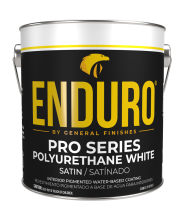 Enduro Water-Based Pro Series White Polyurethane
Enduro Water-Based Pro Series White Polyurethane
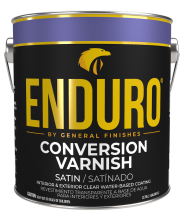 Enduro Water-Based Conversion Varnish
Enduro Water-Based Conversion Varnish
 Enduro Water Based Stain Blocker Primer
Enduro Water Based Stain Blocker Primer
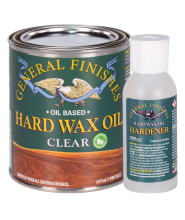 Hard Wax Oil & Hardener
Hard Wax Oil & Hardener
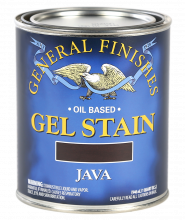 Gel Stains
Gel Stains
 Pro Image Flooring Topcoat
Pro Image Flooring Topcoat
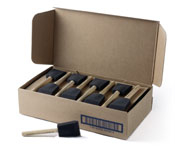 Jen Poly Brushes
Jen Poly Brushes
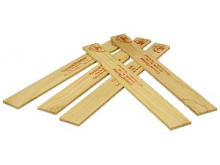 Stir Stix
Stir Stix
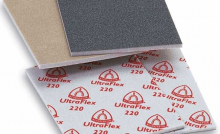 Ultraflex Softback Sanding Sponge
Ultraflex Softback Sanding Sponge
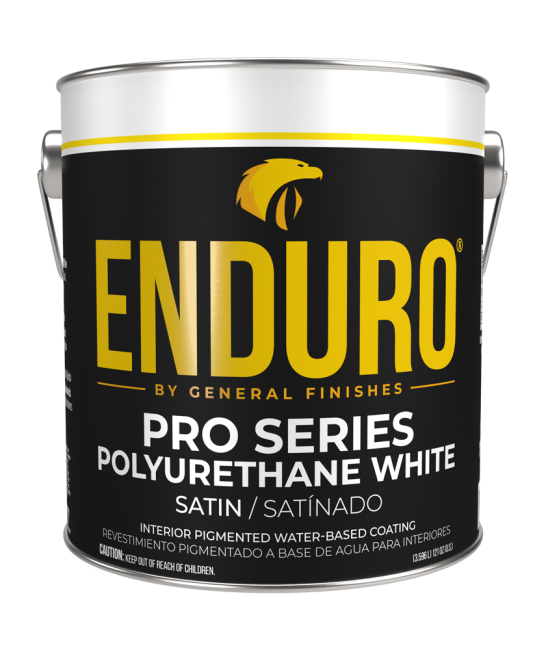
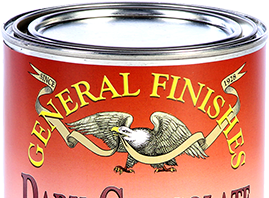
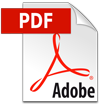 TDS: Enduro Pro Series Polyurethane White 2023-07
TDS: Enduro Pro Series Polyurethane White 2023-07
